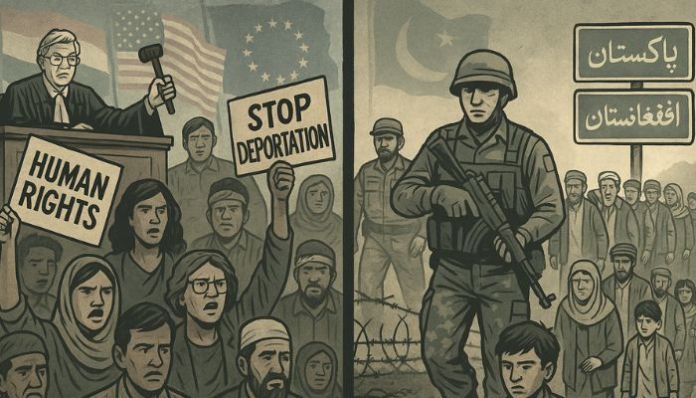Once illegal migrants cross into a country, whether India, the United States or European Union member states, deportation becomes a maze of legal hurdles, political resistance and activist interventions. In theory, sending back those who are in your country illegally should be straightforward. However, it has transformed into protracted court battles, rights-based campaigns and policy paralysis.
Interestingly, while the deportation of illegal immigrants in countries like India is a mess, in contrast, Pakistan is quickly and smoothly deporting Afghans. Reports suggest that by February 2025, over 800,000 Afghans have been pushed by Pakistan into Afghanistan with minimal domestic dissent. When such comparisons are drawn, the dilemma comes into sharp focus: does being a rights-oriented state handicap enforcement?
In India, courts and activists step in almost immediately
India is not a huge country when we compare its land size to China in terms of population. India is overpopulated and space to breathe is decreasing every day. In such a vast country, resources become scarce quite often. Land, food, shelter and jobs are major problems despite being the fourth-largest economy.
In such a country, it is hard to digest that illegal immigrants from Bangladesh and Myanmar (notably the Rohingya) routinely exploit constitutional protections to resist deportation. Once detained, a large number of NGOs, activists and so-called senior advocates like Prashant Bhushan and Kapil Sibal rush to the Supreme Court to stop deportations. Many of the detained illegal immigrants file petitions under Article 21 of the Constitution of India, claiming threat to their life or liberty.
Unfortunately, our legal system mostly favours them and at least stays the central as well as state governments from deporting the illegal immigrants. Even if Supreme Court is in favour of deportation of the illegals, the writs filed by the illegal immigrants, with the help of honed advocates, invariably trigger interim orders that stay removal, and the court case drags on for years.
With such pushback from the legal system, state governments are now trying to expedite matters by bypassing the legal system altogether. For example, Assam’s Chief Minister Himanta Biswa Sarma recently invoked a long-forgotten 1950 law to bypass the Foreigners Tribunal and push the illegal immigrants back into Bangladesh and Myanmar, a move that is being criticised by the so-called human rights activists.
Across the US, sanctuary politics fuel friction
In the United States, once illegal immigrants set foot, deportation similarly becomes a drawn-out, controversial affair. There are sanctuary cities in the US, such as Los Angeles, New York and San Francisco, where authorities are not allowed to question or detain the illegal immigrants. These cities bluntly refuse to cooperate with deportation orders or ICE detainers, viewing them as political weaponisation of law enforcement.
In early June 2025, Los Angeles witnessed dramatic fallout. ICE raids targeting garment workers triggered mass protests, which quickly escalated. Police deployed tear gas and rubber bullets; a Home Depot became a flashpoint. Union leader David Huerta was arrested, prompting outrage. Between 44 and 118 migrants were detained during the operation.
Federal agents responded by deploying 4,000 National Guard troops and 700 marines under Title 10, leading to further unrest, burning cars, blocked highways, injured journalists injured and more. Even the state was sued for unconstitutional federal overreach.
These scenes underscore the tug of war between federal enforcement and sanctuary city politics, amplified by litigation and public protests, making deportation complex, expensive and politically toxic.
Even though the current President of the United States, Donald Trump, is pushing for stricter border enforcement and removing illegal immigrants from the land, the legal system and some specific cities are putting up a tough fight. Among the deported, several hundreds were Indians as well who had entered the US illegally.
In the European Union, human rights conventions result in rigid constraints
In Europe, the strongest barricade against deportation is legal. The European Convention on Human Rights (ECHR) prohibits expelling individuals where there is a risk of torture or inhuman treatment. EU member states must adhere to non-refoulement principles and due process obligations. However, these rules are making the lives of locals a hell. Rampant crimes, rapes of local women and demographic shifts have become common in European countries.
In recent times, there has been pushback against these policies. Amid rising populist pressure, some governments (Italy, Germany, Austria, Denmark) are openly debating reforming or even withdrawing from the ECHR, viewing it as “hampering sovereign control” over migration.
Is tolerance undermining enforcement?
Rights-based democracies pride themselves on due process protections, independent judiciaries and activist pluralism, but these very traits make mass deportation remarkably difficult.
Petitions are filed in the courts regularly, whether under constitutional, international or humanitarian grounds. Sadly, the rulings are mostly in favour of the illegal immigrants and not the citizens of the country. Activists, from grassroots NGOs to civic organisations, mobilise public support, stage legal challenges, organise protests and feed media frenzy.
The left-liberal media amplify individual stories, framing deportation as punitive or a moral failure. Politicians, especially in liberal or sanctuary jurisdictions, avoid enforcement to maintain electoral support.
This system produces delays, expense and fractured enforcement. Deportation orders can take years to execute. Some migrants argue their cases before multiple tribunals; others vanish into legal grey zones. For authorities, each removal requires diplomatic engagement, legal preparation, detention infrastructure and risk management for anticipated backlash.
Pakistan shows what happens without institutional constraints
When the US and NATO forces left Afghanistan and the Taliban took over, lakhs of Afghanis migrated to Pakistan and other parts of the world illegally. Pakistan started pushing back Afghans soon enough. Between 2023–25, there were waves of deportations targeting undocumented Afghans. Estimates from the UN and Pakistani sources place the number of deported at over 813,300 by January 2025, and nearly a million by June 2025.
Why the indifference? Because Pakistan lacks robust independent judiciary protections, a confrontational press or mobilised civil society. The security narrative prevailed, framed around terrorism and national stability. International actors, UN agencies and rights groups, expressed concerns but held little leverage. Basically, everyone has made peace with the fact that there are no human rights in Pakistan.
Being tolerant comes at a cost
In effect, rights-respecting societies tie their own hands. Legal frameworks, activist resistance and public sentiment erect invisible walls around undocumented migrants. The ethical virtues of justice and liberty slow administrative action, often to a crawl.
Pakistan is an alternative, a system so unhinged that legal and civic constraints simply do not have any effect on large-scale deportations. Yet, it also reveals the chilling absence of accountability, transparency or due process, so India can’t go down that path.
Now the question is, which model is preferable? Rights-oriented democracies may be slower, messier and legally combative, but they preserve personal liberty. Countries that discard those safeguards may achieve enforcement targets, but at the cost of rule of law, oversight and basic humane treatment. India cannot behave like Pakistan, but it has to draw a line somewhere, for the sake of maintaining law and order and for its citizens.













